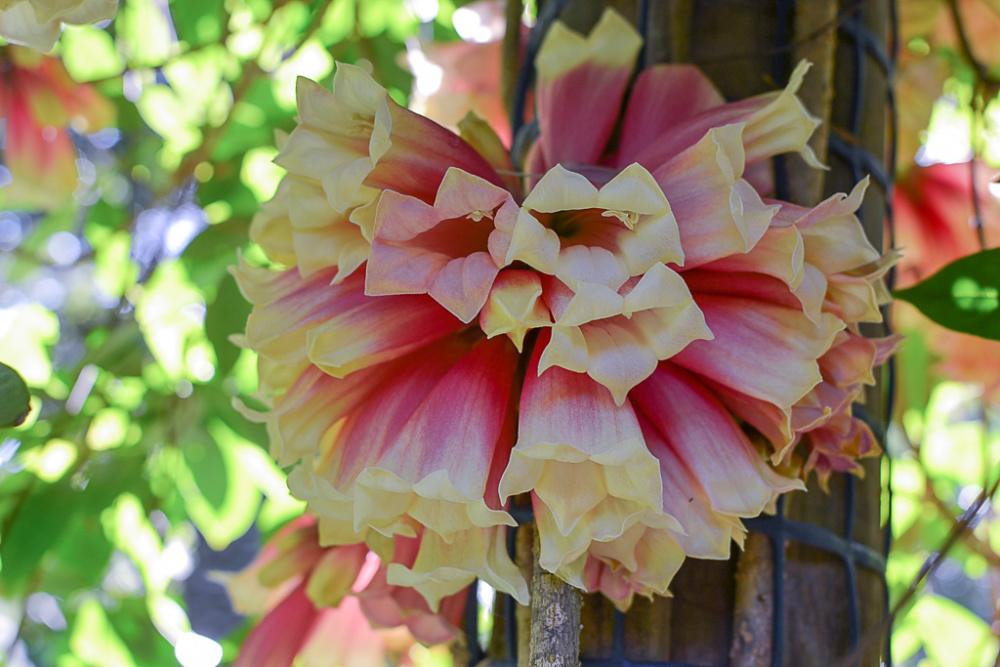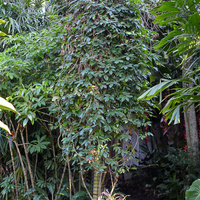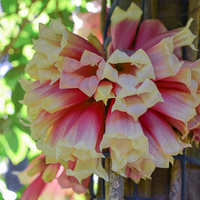Common name: New Guinea trumpet creeper
Other common names: Forest bell creeper, New Guinea creeper
Description
Originating from Papua New Guinea, this flowering vine grows fast and vigorous, forming a criss-cross entanglement of woody stems.
The stems are grey-barked, up to 1 cm (0.4 in) thick, 10 to 20 m (33 to 66 ft) long, and climb up, around and over vertical structures, in some cases completely covering them.
Leaves are compound, comprised of either two, four or six leaflets arranged in pairs along the length and with an extra leaflet at the tip. Individually, the leaflets are elongated-oval, 6 to 7 cm (2.4 to 2.8 in) long, smooth on the margins and dark green. They fall off the vine in the dry season to conserve water, exposing the stems.
Flowers are trumpet-shaped, 6 to 12 cm (2.4 to 4.7 in) long, rose-pink outside, creamy-white inside and on the lips, and borne in large pendant clusters of up to sixteen. They bloom intermittently from autumn to early spring and are at their best display on the bare stems in the dry season, coinciding with winter in its native range. Fertilised flowers develop into thin, leathery, woody seedpods 17 to 30 cm (7 to 12 in) long with small winged seed inside.

Use
It is cultivated for its clusters of large, colourful trumpet-shaped flowers, lush green foliage and its ability to grow quickly and cover walls, fences, trellis and arbours. A vigorous vine, it needs a solidly built structure to support its weight as it grows.
Climate
Grows naturally in humid subtropical and tropical lowland climates, generally frost-free areas with annual lows of 18 25°C, annual highs of 27 to 34°C, annual rainfall of 1200 to 4500 mm and a dry season of 6 months or less.
Growing
New plants are started from semi-ripe cuttings, less commonly from seed. Performs best on sites with full to partial sun exposure, and on rich, free-draining clay, loam or
sand soils of a moderately acid to neutral nature, generally in the 6.0 to 7.5 pH range.
Problem features
The seed are small, germinate readily and are designed for wind dispersal. However, there does not appear to be any record of it anywhere as a weed or invasive species, despite its introduction into areas outside of its native range. It is assessed as a low weed risk species for Hawaii by the Hawaii Pacific Weed Risk Assessment (HPWRA) project.
It has a smothering habit, sometimes overgrowing shrubs and even small trees, restricting their access to sunlight, eventually killing them.
Where it grows
References
Books
-
Griffiths, M. & Burras, J. K. 1994, Manual of climbers and wall plants, Royal Horticultural Society (Great Britain), Timber Press, Portland, Oregon
-
Menninger, E. A. 1970, Flowering vines of the world : an encyclopedia of climbing plants, Hearthside Press, New York
-
Oakman, H. 1995, Harry Oakman's what flowers when : the complete guide to flowering times in tropical and subtropical gardens, University of Queensland Press, St. Lucia, Queensland
-
Randall, R. P. 2007, The introduced flora of Australia and its weed status, Cooperative Research Centre for Australian Weed Management, Glen Osmond, South Australia
-
Rauch, F. D. & Weissich, P. R. 2000, Plants for tropical landscapes : a gardener's guide, University of Hawaii Press, Honolulu
Articles, Journals, Reports and Working Papers
-
Park Brown, S. G. & Knox, G. W. 2007. Circular 860. Flowering Vines for Florida. University of Florida, Gainesville: Env Hort Dept.



